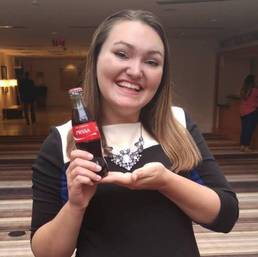 By Hanna Moore I was fortunate enough to attend PRSSA National Conference this November for the second time, where I was able to listen to speakers discuss various topics relevant to public relations and communication. My favorite session this year was “Building Personalized Experiences” from Scott Cuppari (@scottcuppari), Global Marketing Director for Coca-Cola Freestyle. As soon as I read over the list of presentations, I was immediately drawn to this one. I have been brand loyal to Diet Coke and Coca-Cola for as long as I can remember, so I was thrilled to have the opportunity to hear from one of its directors first hand. Cuppari began by asking the room who had heard of a Coca-Cola Freestyle machine. About half of the people raised their hands. He then asked how many people had seen the “drink machines from the future.” Everyone in the room raised their hands. He asked us if we could remember the first time we had seen a Coca-Cola Freestyle machine, and my friend and I both looked at each other and immediately said “Five Guys!” Listening to someone from some a well-known brand that has strong marketing campaigns was a dream come true. Cuppari shared personal career experiences that shaped how he got to his current career and offered some advice, such as “Don’t get complacent,” “Everything can change in the blink of an eye” and “Challenge yourself — think broader! Always ask questions.” Cuppari used his experience at Coca-Cola Freestyle to describe how personalized marketing campaigns have changed the customer experience. He said that this is the “age of personalization,” and that the challenge is to turn a mass-produced product and make it into a personalized experience for customers. Some of the ways Coca-Cola Freestyle has been able to market directly to customers in a one-to-one world are through Coca-Cola’s “Share a Coke” and Powerade’s “Just a Kid” campaigns. The session mostly focused on the Coca-Cola Freestyle machines, which have more than 150 options for consumers. Cuppari described the four types of media: owned, your own website and social media channels; paid, advertising; earned, third-party endorsements and media coverage; and shared, your partners’ and consumers’ social media channels. I have heard about owned, paid and earned media in my classes, but the idea of using shared media was unique and is something to consider when looking at types of media. Cuppari also encouraged us to think of consumers in the context of a “pinball machine” because you don’t know where they came from, but they should still be in the center of your marketing. He finished the presentation by showing success Coca-Cola Freestyle has had with marketing and the role that big data had in the campaign. Overall, this was a great session that inspired me to think of marketing as a personalized experience for consumers, rather than a “one size fits all” campaign for all consumers. My key takeaways from the session are:
0 Comments
PRSSA National Conference Review: Integrated Marketing Communications Through Social Media12/10/2013 by Navjot Grewal
Today we hear a lot about Integrated Marketing Communications, but what does it mean for PR professionals in the age of social media? Keith Quesenberry shared useful advice on how to integrate social media in communications at the PRSSA 2013 National Conference in Philadelphia. Quesenberry, a lecturer in the Center for Leadership Education at the Johns Hopkins University and instructor at the Integrated Marketing Communications (IMC) Graduate Program at West Virginia University, said that traditional IMC that delivers consistent messages through “consumer touch points” (anything that reaches the consumer) does not work today in the age of Web 2.0 Organizations should start interacting with social media consumers who trust each other more than the businesses, Quesenberry said. He outlined five steps to include social media integration into business communication: 1. Integrate Social Media through Research Social media can be used to monitor and understand what is being said about you and your competitors. Using various free and paid services like Google Analytics and HubSpot can do this. 2. Integrate Social Media through Crowd Sourcing You can do big tasks by getting your consumers involved. Crowd Sourcing helps capture ideas, engage consumers and discover what ideas work. 3. Integrate Social Media through Branded Content Give valuable content to your consumers through social media. Best Buy developedTWELPFORCE, a 24/7 expert technical helpline from employees, which reduced consumer complaints by 20 percent in its first year. Set social media guidelines and let your employees speak for you. 4. Integrate Social Media through Customer Evangelism Find mass connectors and mass mavens, and reach out to them. Identify your customer evangelist network. 5. Integrate Social Media through Customer Service Fill the communication gap between you and the consumer by responding to them on social media. However, Quesenberry advises to take the consumer offline in the case of addressing complaints once the conversation has been initiated. |
Archives
February 2024
Categories
All
|
 RSS Feed
RSS Feed
